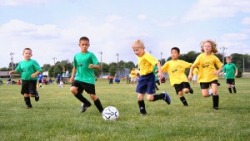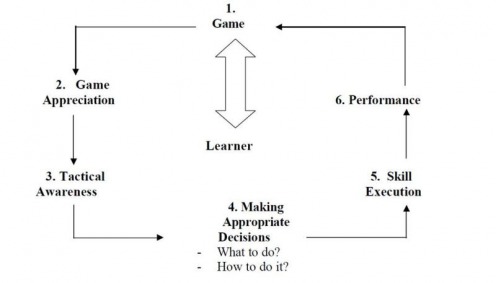The "Teaching Games for Understanding" Model
The Teaching Games for Understanding (TGfU) Model:
The Teaching Games for Understanding model incorporates 6 key stages which include: (1) Game-Focus, (2) Game Appreciation, (3) Tactical Awareness, (4) Decision Making, (5) Skill Execution and (6) Performance (Thorpe & Bunker, 1986). Thus, when implementing TGfU, the development of any game follows the model presented in Figure 1.
The Teaching Games for Understanding model incorporates 6 key stages which include: (1) Game-Focus, (2) Game Appreciation, (3) Tactical Awareness, (4) Decision Making, (5) Skill Execution and (6) Performance (Thorpe & Bunker, 1986). Thus, when implementing TGfU, the development of any game follows the model presented in Figure 1.
Game: As the model indicates, learning is game-based whereby there is always some form of opposition. In this stage, the students must first become capable of understanding the form of the game before they can recognise the problems to be solved.
Game Appreciation: In recognising the purpose of the game, time should be given for students to see what the game is all about. Gradually, students will develop an understanding of the main rules that shape the game.
Tactics: Problem solving is a critical approach to teaching games for understanding. Beginners are introduced to tactics through a gradual introduction of movement principles, based on simple ideas of space and time (Werner, Thorpe & Bunker, 1996). Hence, Thorpe & Bunker (1986) recognise that just as skills transfer across games, so will tactical knowledge.
Decision Making: With increased appreciation of the game and tactical knowledge, students show a much greater understanding of when and how to perform skills. In addition, they also develop appreciation of the factors which influence decision making in executing skills in regards to time, space and positioning.
Skill Execution: In the TGfU model, skill execution is used to describe the actual production of the required movement as envisaged by the teacher and seen in the context of the learner.
Performance: This is the observed outcome of the previous processes measured against criteria that are independent of the learner. Thus, performance is measured based on the appropriateness of the response and efficiency of the technique.
Game Appreciation: In recognising the purpose of the game, time should be given for students to see what the game is all about. Gradually, students will develop an understanding of the main rules that shape the game.
Tactics: Problem solving is a critical approach to teaching games for understanding. Beginners are introduced to tactics through a gradual introduction of movement principles, based on simple ideas of space and time (Werner, Thorpe & Bunker, 1996). Hence, Thorpe & Bunker (1986) recognise that just as skills transfer across games, so will tactical knowledge.
Decision Making: With increased appreciation of the game and tactical knowledge, students show a much greater understanding of when and how to perform skills. In addition, they also develop appreciation of the factors which influence decision making in executing skills in regards to time, space and positioning.
Skill Execution: In the TGfU model, skill execution is used to describe the actual production of the required movement as envisaged by the teacher and seen in the context of the learner.
Performance: This is the observed outcome of the previous processes measured against criteria that are independent of the learner. Thus, performance is measured based on the appropriateness of the response and efficiency of the technique.

